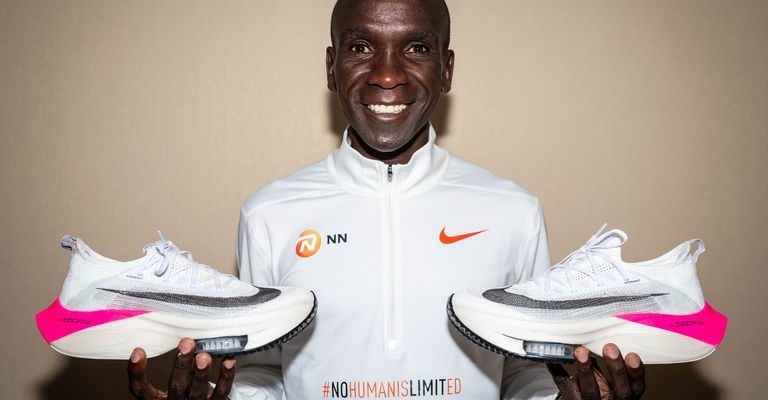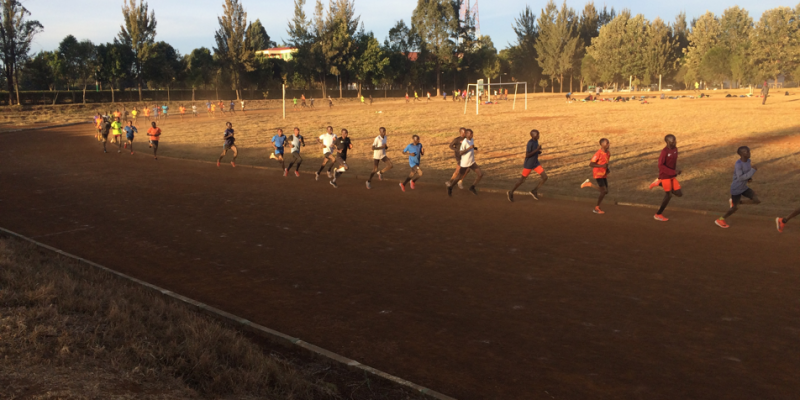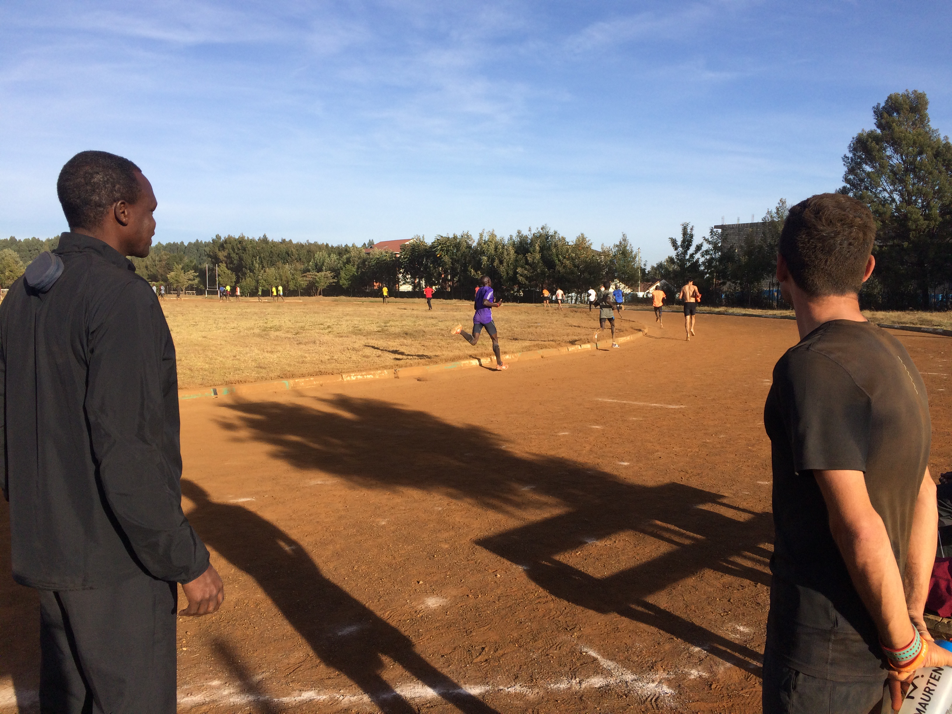In this episode of the Art and Science of Running Podcast, we discuss the history of the Breaking 2 project, the Ineos 1:59 Challenge, collaborative coaching, the evolution of footwear, fuelling, pacer formations, world marathon records, doping, mechanical doping, and more.
The History of Breaking 2
It all started at the 2013 Great North Run (Half Marathon) between the all-time greats, Haile Gebrselassie, Kenenisa Bekele, and Mo Farah.
Yanis Pitsiladis, the foremost expert in genetics in East Africa based at the University of Brighton formulated the sub 2:00 concept. Pitsiladis approached the 2 hour barrier through a collaborative effort at various universities, but his project ultimately stalled and stopped growing.
In 2016 Nike launched its own project. After his marathon debut in 2014, Kenenisa Bekele was headhunted to be one of the athletes to prepare to break 2 hours. Ultimately, it was not Bekele, but rather Kipchoge of Kenya and two others, Zersenay Tadese of Eritrea, and Lelisa Desisa of Ethiopia.
Breaking 2 was truly scientifically motivated. Ultimately Kipchoge ran 2:00:25.
Alex Hutchinson was there and wrote about the experiment in Endure: Mind, Body, and the Curiously Elastic Limits of Human Performance.
After coming within 25 seconds of the 2 hour barrier in Breaking 2, Kipchoge broke the world record in Berlin in 2018 in 2:01:39. After running and winning the London Marathon in 2019 the best option to try to break 2 hours in a controlled setting would be the Fall of 2019 before focussing on the 2020 Olympics.
In episode 4 with Alex Leuchanka, the Senior Applied Innovation Officer for VF Corp we discussed some of the work he and others are doing in the field of data collection in biomechanics. Alex mentioned a key note address at a conference he had attended in the area detailing the extensive data collection Nike had been doing to inform shoe design.
Nike was able to predict with hyper accuracy what Kipchoge was going to run at Berlin based on the models they were able to create from the data collected win training. Leading up to the Ineos 1:59 there was so much data collected over the years that there was little doubt that Kipchoge would not break 2:00.
“If you can take anything out of this, it is that Kipchoge is an absolute role model for any runner in mindset and mind control. . . [He is] amazing at being able to turn up on the day and execute. His ability to get into this flow state / mindset / brain state is insanely good. His ability to stay concentrated and relaxed for two hours, but he could also take direction while on the run. He naturally has this ability to drop in and out of flow state for two hours straight which makes him hyper efficient.”
Malc Kent
Coach / Athlete Relationship
The coach / athlete relationship between Kipchoge and Patrick Sang is more collaborative and athlete guided than some might suspect.
The goal of a coach is to help our athletes not need us. Ultimately, the goal of both coach and athlete is to trust the process with the goal of long term-development.
As we discussed in Episode 2 of the Art and Science of Running Podcast, Eliud is the patriarch of the group.
“What is amazing is how incredibly anchored and stable he is. He could have looked things up on the Internet and second guessed what he was doing, but he didn’t. He accepted the process, the simplicity.”
Malc Kent
Introducing the Nike Vaporfly 4%
The Nike Vaporflies were worn in competition for the first time at 2016 US Olympic Marathon Trials.
With some metabolic data studies it was determined that the original Vaporflys gave an average of 4% increase in running economy and as much as 6%.
As discussed in Episode 4 of the Art and Science of Running Podcast, the distinguishing feature of these shoes is the Pebax foam with carbon fibre plate.
Latest available model in this line is called the Nike Zoom Vaporfly Next %.
Kipchoge wore the “Alphaflys” in the Ineos 1:59 Challenge. These shoes are believed to also include pebax foam, forefoot pods, and multiple carbon fiber plates.
Although these shoes were not shared with the general public until just before the Ineos 1:59 Challenge, Nike filed a patent application in US in November 2018 for the concept of the shoe worn at the Ineos 1:59 Challenge.
So without taking away from all that Kipchoge and others have accomplished in these new Nike technologies, it begs the question:
Is it the shoes?
Would Kipchoge have been able to break 2 without the shoes?
Would Bekele have been able to do what he did by almost besting Kipchoge’s mark in the marathon without the shoes?
Would others have been able to do what they have done without the shoes? (See lists of top marathon times of all time).
Rodger Cram’s study of the original Nike Vaporfly prototype showed an improvement of 4%.
And it is rumoured that the Next % gives even more back.
For comparison of the Nike Vaporfly models and how / why their return varies from model to model:
Stack heights – height of mid sole.
- Vaporfly 4% return, 31 mm
- Next % – 5% return, 36 mm
- Alphafly – 6% – possibly more, 41 mm
But this isn’t just about metabolic tests in a lab. Times are dropping at an unprecedented rate.
See list of all time fastest marathon times and courses: https://www.runnersworld.com/races-places/a20823734/these-are-the-worlds-fastest-marathoners-and-marathon-courses/
Eight out of ten of the ten times of all time have been run since 2016 and the advent of the Nike Vaporflys.*
“It is not unreasonable to suggest that the shoe that we are looking with pebax foam has about twice the energy return of comparable foams.”
Malc Kent
There is no question that the shoes helped Kipchoge run sub 2:00 in Vienna.
What could Kipchoge do if he wore the Nike Zoom Streak 6?
Malc mentions a trend that the heavier the runner the more return they get from these new Nike Vaporflies.
According to the data Malc has recorded and analyzed, trends in the data indicate that the heavier the runner the greater the advantage that they get.
Supply and Demand
Pebax is a naturally occurring crop. The demand is greater than the supply. Nike has already monopolized the available Pebax in the world (China).
A number of formerly sponsored athletes by non-Nike brands elected to wear Nike Next % at the Canadian Marathon Trails and saw big improvements at the Toronto Waterfront Marathon.
Read more at Inside the Race that Changed Canadian Marathoning.
Rather than wearing the Vaporflies, Jacob is currently working with Alex to try to develop the best shoe that they can before CIM.
Doping vs. Mechanical Doping
Those who use EPO as a performance enhancer hope to get 4-5% of an improvement gain. Recent improvements over the marathon distance indicate that those who use the Vaporflies are getting at least as much of a boost from the shoes as they would if they were using synthetic EPO.
Relative to history, how do recent performances in the Vaporflies stack up?
See list of all time fastest marathon times and courses: https://www.runnersworld.com/races-places/a20823734/these-are-the-worlds-fastest-marathoners-and-marathon-courses/
Let’s Run Founders suggest that the results of the 2016 Olympic Marathon should be overturned. This would include the results of the 2016 US Marathon Trails because those who qualified and medaled were wearing Vaporflies which were not available to the general public which technically is against IAAF rules. https://podcasts.apple.com/ca/podcast/letsrun-coms-track-talk/id383631335?i=1000453816857
One argument against banning the Nike Vaporflies that Alex Hutchinson makes in the Clean Sport Collective and House of Run podcasts is that Adidas and Fila each had shoes with carbon fiber plates including the shoes that Haile Gebrselassie wore to set a new marathon world record. Clean Sport Collective Podcast & House of Run Podcast.
Some of these shoes were conceptualized in Calgary at the University of Calgary. For more information on the extensive biomechanical work done in this department, listen to this podcast with head of department at the University of Calgary, Benno Nigg, with Malc Kent: https://runfisix.com/blogs/podcasts/benno-nigg
Geoffrey Burns argues that we can and should embrace innovation and technology, but there should be limits in order to preserve the integrity and ethos of the sport. Burns suggests a restriction of stack height to regulate artificial advantage.
https://blogs.bmj.com/bjsm/2019/10/14/shoes-and-sub-2-hr-marathon/
Burns also suggests that in order to maintain the tradition of fair play in the sport and the ability to compare records from generation to generation there should be some restrictions to technological advancements:
https://www.geoffreyburns.com/stream/trading-souls-for-soles
Malc thinks that perhaps a lower profile shoe like the one worn by Gebrselassie or the Nike Zoom Streak would be truer to the ethos of fair sport, whereas Burns is allowing the original Vaporflies to be counted.
Doping is not just about performance on race day, but recovery in training so that greater gains can be made before race day.
“If the shoes are allowing you to do two more reps per session or add a few more quality training sessions without as great a need for recovery between long runs and workouts that is giving the athlete an advantage comparable to the advantages given by using EPO or other banned substances.”
Jacob Puzey
In the year 2000 only one American male had run the Olympic qualifier, yet in 2019 at the Chicago Marathon 10 American men ran under 2:12 – all wearing either the Nike Vaporflies or Hoka and Saucony equivalents (or attempts to compete with the Vapoflies, etc.)
Read more on the results and the impact of the shoes: https://www.runnersworld.com/news/a29452570/chicago-marathon-american-men-results-2019/
Malc challenges listeners to watch the last five minutes of the Ineos 1:59 and decide how powerful the shoes are. Propulsion is one thing and reduction of fatigue is another thing. That’s the power of shoe technology right there.
All of this and more in Episode 9 of the Art and Science of Running Podcast.
Intro and outro music by Dallin Puzey, GOIN 4 A WALK.
Please listen, subscribe and rate this podcast on Apple Podcasts, Spotify, Stitcher, YouTube, or wherever you listen to podcasts.
Please follow us on Twitter, Instagram, and Facebook and let us know what you’d like us to discuss in future episodes.
For more discussion on theses topics, please read:
https://www.podiumrunner.com/yes-those-nike-shoes-are-too-fast-but-should-we-ban-them_178824
https://amp.theguardian.com/sport/blog/2019/oct/21/shoes-nike-world-records-technology
https://www.nytimes.com/2019/10/18/sports/marathon-running-nike-vaporfly-shoes.html
https://www.runnersworld.com/uk/gear/shoes/a29455211/eliud-kipchoge-nike-shoes/
https://www.runnersworld.com/uk/gear/shoes/a29558499/ban-kipchoge-nike-shoes-vaporfly/
https://www.amazon.com/Kicksology-Science-Culture-Running-Shoes/dp/1937715914
Or listen to these podcasts:
Magness and Marcus On Coaching Podcast:
https://podcasts.apple.com/ca/podcast/magness-marcus-on-coaching/id961516002?i=1000454001855
Citius Mag Podcast with Chris Chaves:
Additional resources to read and review:
Sandy Bodecker https://runningmagazine.ca/the-scene/nike-breaking2s-sandy-bodecker-dies/
4% shoe study https://link.springer.com/article/10.1007/s40279-017-0811-2
Ineos challenge info https://www.ineos159challenge.com
Alphafly shoe info https://www.believeintherun.com/2019/10/09/a-breakdown-of-the-nike-kipchoge-prototype/
Original sub 2 project https://www.sub2hrs.com/
Breaking2 info https://www.nike.com/ca/en_gb/c/running/breaking2
Brad Wilkins info https://w124.co/about/
NN Running info https://www.nnrunningteam.com/
Podcast: Play in new window | Download
Subscribe: Apple Podcasts | RSS | More



